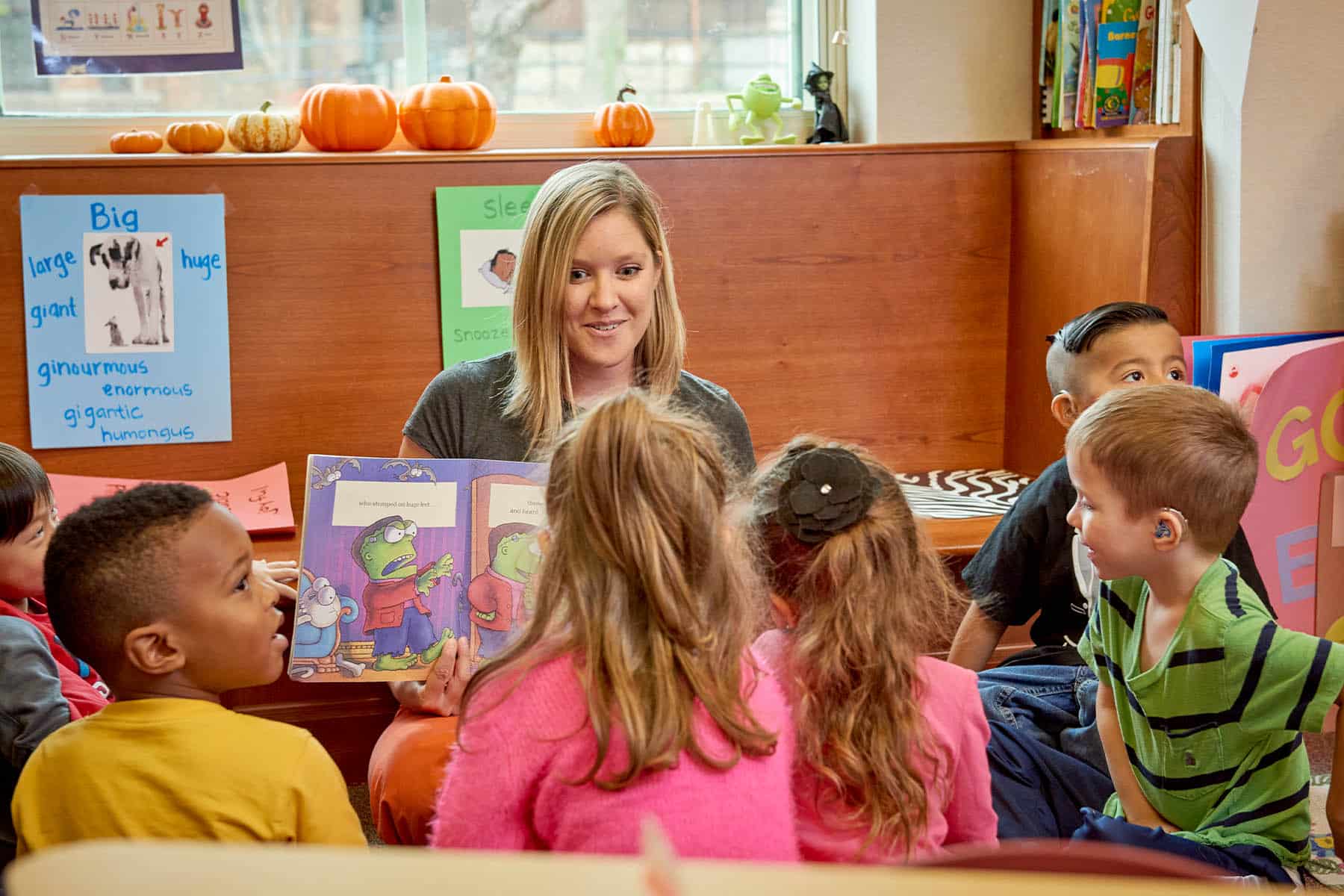Fragmented Hearing -> Effort -> Listening Comprehension -> Fatigue -> Pace of Learning
Communication access is required for a student to have an equal opportunity to perform optimally in school. This level of access should be as effective for children with hearing loss as it is for their typically hearing peers. Whether the student is an auditory or visual learner, each student’s access needs should be determined individually, considering the communication used by the student, the nature, length and complexity of the communication involved, and the context in which the communication is taking place.
Someone observing a student with hearing loss may believe that he or she has an attention problem or a learning disability as hearing loss can also impact perceiving, language processing, processing speed, memory and attention. Unlike ADHD or LD, learning issues caused by hearing loss are not due to a disorder (an issue with brain processes). Instead, the learning issues are secondary to delays because the child has incomplete access to speech occurring around him or her, especially soft speech or completely understanding someone talking from a distance further than 3-6 feet. In the U.S., for every 100 students receiving specialized instruction due to disability, only one has been made eligible for this support- primarily due to hearing loss. One of the biggest challenges in the field of education of children who are deaf or hard of hearing is the need to inform (convince) the teachers and school staff that a student’s educational issues are the result of incomplete access to information- not a learning disability, attention deficit or language disorder.
Fragmented Hearing
Our educational system is based on the assumption that students in the classroom will perceive, and therefore understand, all of what the teacher is saying. When much information received in school is fragmented because of hearing loss, learning consequences are likely. Even with the latest hearing technology, normal hearing ability is not restored by hearing devices. Even aided thresholds of 20 dB HL cause soft speech, high pitch speech sounds and unemphasized brief words to be undetected or too quiet to process. It is not unusual for children with hearing loss to have a 20% ‘listening gap’ as compared to class peers who may miss only 5% of information1.
Increased Effort
Listening effort refers to the attention necessary to understand speech. Even low noise in the environment will interact with the fragmented hearing to interfere with their speech understanding. Children with hearing loss work harder than their peers to listen leaving fewer cognitive resources to understand speech in the classroom as compared to classroom peers. Research2-4 makes it clear that speechreading (lipreading) helps children to compensate for what was missed due to hearing loss but ONLY if a child is a GOOD speechreader AND he has typical or better working memory capacity.5 Extracting speech in the presence of background noise reduces the listener’s ability to mentally rehearse material that is heard so it can be remembered. It is important to assess speechreading ability (e.g., Functional Listening Evaluation6) and the memory capacity (in quiet and noise) of students with hearing loss (e.g., Test of Auditory Processing Skills – TAPS-37).
Decreased Listening Comprehension
Listening comprehension abilities of children with hearing loss are typically poorer than those of children with normal hearing due to the effort used to listen, which decreases the cognitive resources available to understand what was heard. Unless the acoustic conditions of the classroom are considered, the educational environment will impact the ability of a child with hearing loss to follow directions.
Performing tasks such as those included in the Listening Comprehension Test 28 provides valuable information about how the student with hearing loss comprehends what he hears. Using an FM while doing this test provides the student’s best possible listening comprehension performance on these higher cognitive tasks. Also, asking the family to complete the Children’s Hearing Inventory for Listening Difficulties (CHILD)9 checklist for young children or having the student (age 8+) complete the Listening Inventory For Education-Revised Student Appraisal10 will provide valuable information about specific types of situations that are challenging.
Increased Fatigue from Listening/Processing
There is a connection between increased cognitive processing demands when listening to speech in noise and fatigue-related changes in cognitive processing ability. Because fatigue has an impact on cognitive processing, it is not surprising that recurrent fatigue (which can be caused by the added strain of listening with hearing loss) is associated with reduced academic performance in children.
Researchers11-13 who examined the question of fatigue in children with hearing loss found that children with hearing loss subjectively report a greater level of fatigue than those with typical hearing. They also truly exert more effort on listening tasks than their typically hearing peers. This was found to NOT be related to differences in language ability. Any degree of hearing loss, with or without amplification, resulted in greater effort. The fatigue experienced by children with hearing loss is substantial, even when compared to children with other chronic health conditions, such as cancer, diabetes, and rheumatoid arthritis. The Informal Assessment of Fatigue and Learning9, 14 can help to quantify if there is a learning effort-reward imbalance and overall level of fatigue.
Pace of Learning Decreases
Hearing loss creates barriers to learning in the typical classroom environment and impacts social interactions. This invisible barrier typically causes CUMULATIVE learning gaps due to incidental learning/overhearing deficits. A review of the collected post-universal newborn hearing screening research15 revealed important outcomes. These include: (1) children who are identified early and receive early intervention have been found to demonstrate language development in the “low average” level compared to hearing children, and (2) many, if not most, children with hearing loss who use listening and speaking for learning fail to keep pace with hearing peers (even those with cochlear implants). Although we live in a time when the potential of children with hearing loss is more likely to be reached than ever before, the reality is that the gains of early childhood are often eroded by the challenges of learning in a non-supportive auditory environment.
SUMMARY
- Because hearing loss is invisible, the effects of fragmented hearing on effort, listening comprehension and fatigue are often ignored by educators.
- A good start to typical language learning does NOT inoculates a child from the learning challenges caused by being educated in a typical classroom environment.
- Classroom hearing assistance technology is a necessary and effective accommodation for listening to the teacher’s speech, but less so for all other classroom communication.
- We must ensure equal, effective access to communication if students with hearing loss are to have an equal opportunity to succeed in school.
References
- Bodkin, K., Madell, J., & Rosenfeld, R. (1999). Word recognition in quiet and noise for normally developing children. American Academy of Audiology Convention, Miami, FL, Poster session. Download Speech in Noise Norms for Typical Children from https://successforkidswithhearingloss.com/speech-perception
- Picou, E. M., Ricketts, T. A, and Hornsby, B. W. Y. (2011). Visual cues and listening effort: Individual variability. Journal of Speech. Language, and Hearing Research, 54, pg 1416-1430.
- Fraser, S., Gagne`, JP., Alepins, M., & Dubois, P. (2010). Evaluating the Effort Expended to Understand Speech in Noise Using a Dual-Task Paradigm: The Effects of Providing Visual Speech Cues. Journal of Speech, Language, and Hearing Research, 53, 18-33.
- Howard, C. S., Munro, K. J., & Plack, C. J. (2010). Listening effort at signal-to-noise ratios that are typical of the school classroom. International Journal of Audiology, 49(12), 928-932.
- Beaman, C.P. & Roer, J. P. (2009). Learning and failing to learn in immediate memory. In 31st Annual Meeting of the Cognitive Science Society, Austin, Texas, USA. https://www.academia.edu/2407326/Learning_and_failing_to_learn_in_immediate_memory
- Functional Listening Evaluation – find information at https://successforkidswithhearingloss.com/tests and https://successforkidswithhearingloss.com/fle-recorded
- Martin, N. A., & Brownell, R. (2005)Test of Auditory Processing Skills, Third Edition (TAPS-3). Novato, CA: Academic Therapy Publications. Available from https://successforkidswithhearingloss.com/taps-3
- Schafer, E., Bryant, D., et. al, (2013). Listening comprehension in background noise in children with normal hearing. Journal of Educational Audiology, 19, 58-64.
- The following checklists can be found at https://successforkidswithhearingloss.com/tests : CHILD, Starting School LIFE, SIFTERs (Screening Instrument For Targeting Educational Risk), Informal Assessment of Fatigue and Learning
- LIFE-R Teacher Appraisal can be found at https://successforkidswithhearingloss/tests/life-r
- Valente, D. L., Plevinsky, H. M., Franco, J. M., Heinrichs-Graham, E. C., & Lewis, D. (2012). Experimental investigation of the effects of the acoustical conditions in a simulated classroom on speech recognition and learning in children. Journal of the Acoustical Society of America, 131(1), 232-246.
- Hornsby, B., Werfel, K., Camarata, S., & Bess, F. (2014), Subjective fatigue in children with hearing loss: Some preliminary findings. American Journal of Audiology, 23, 129-134.
- Hicks, C. B., & Tharpe, A. M. (2002). Listening effort and fatigue in school-age children with and without hearing loss. Journal of Speech, Language, and Hearing Research, 45, 573-584.
- Fukuda, S., Yamano, E., Joudoi, T., Muzuno, K., Tanaka, M., Kawatani, J., Takano, M., Tomoda, A., Imai-Matsumura, K., Miike, T., & Watanbe, Y. (2010). Effort-reward imbalance for learning is associated with fatigue in school children. Behavioral Medicine, 36(2), 53-62.













